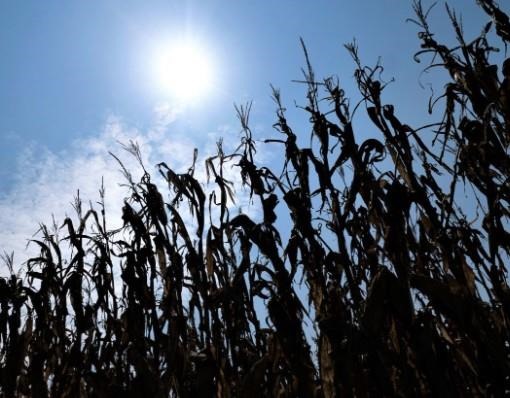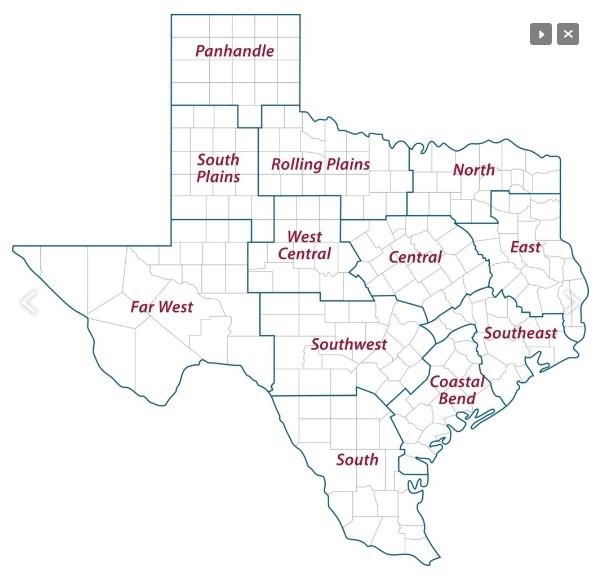The high temperatures crops experienced over recent weeks across much of the state could translate into lower yields for producers, according to a Texas A&M AgriLife Research expert.
 Unrelenting high temperatures and drought conditions are taking their toll on Texas crop production. (Texas A&M AgriLife photo by Laura McKenzie)
Unrelenting high temperatures and drought conditions are taking their toll on Texas crop production. (Texas A&M AgriLife photo by Laura McKenzie)Lee Tarpley, Ph.D., AgriLife Research plant physiologist, Beaumont, said the recent heat wave arrived at a bad time for rice fields along the Gulf Coast. The triple-digit temperatures coupled with lingering drought conditions are also likely to negatively impact other crops during sensitive production stages.
All plants and vegetation experience heat stress when daytime and nighttime temperatures hit extreme highs like Texas has experienced over recent weeks. Heat and drought can stress plants, damage their cell membranes and disrupt metabolic efficiency during processes like photosynthesis and respiration, Tarpley said.
But the combination of high daytime and nighttime temperatures can economically damage commodity crops, especially during sensitive growth periods like flowering, he said.
“The period of high temperatures came so early that it will likely hit a lot of crops when they are most sensitive,” he said.
High temperatures influence plant function
For example, Tarpley said the cotton fields endured 100-plus degree days, above-normal nighttime temperatures and less than optimal soil moisture levels at bloom. The convergence of conditions is likely to translate into aborted squares and thus fewer pounds per acre or discounted gradings.
Rice and other grains experience similar yield loss under stressful conditions, but differently. Heat and moisture stress lead to reduced seed set and grain fill as heat leads to oxidative stress and can damage flower parts and developing reproductive structure.
High temperatures can also negatively impact the viability of pollen, which can influence how the ultimate crop sets and fills out, Tarpley said. Texas watermelon and cantaloupe producers reported pollination viability issues due to high temperatures earlier this season.
“Pollen development is a heat-sensitive period for rice and some other crops,” he said. “That stage precedes flowering by 10-14 days, and it was in the upper 90s during the day, which is rare for Beaumont. So, I expect there to be some impact on pollen development in rice fields.”
Some later-planted crops, like corn and cotton in the Texas Plains, could also be more susceptible to the recent heat wave, especially in drier areas and if hot, dry conditions persist, Tarpley said.
Texas A&M AgriLife Extension Service reports indicate dryland acres in drought-stricken parts of the state were suffering even before the recent heat wave. Many planted crop acres have not emerged and were replanted with other crops that were also showing signs of drought stress or have not emerged.
Water restrictions as drought deepens
Tarpley said he is concerned about water restrictions due to drought and their impact on irrigated crops, including rice, which needs shallow flooded fields. Restrictions could inhibit water pumping from canals. As fields dry down, nitrogen fertilizer becomes volatile in the heat and decreases its availability, further contributing to production losses related to the input cost and the ultimate reduction in yield potential.
“We’ve heard some reports of anticipated lower yields in rice, but nothing alarming so far,” he said. “The question for rice is keeping the fields flooded, which comes down to water availability.”
Water restrictions are also a concern for other parts of the state, including West and South Texas. Pecan and cotton producers in West Texas rely on water from the Elephant Butte Reservoir in New Mexico, which has provided limited water. Some crops in that area have received effluent water from El Paso.
The Rio Grande Valley, which produces a wide range of crops, relies on water released from Lake Amistad near Del Rio and Falcon Lake south of Laredo, but reservoir capacities have been declining. Lake Amistad sits just above 36% capacity, while Falcon Lake is just under 16% full.
AgriLife Extension district reporters compiled the following summaries:
 A map of the 12 Texas A&M AgriLife Extension districts.
A map of the 12 Texas A&M AgriLife Extension districts.CENTRAL
Record hot conditions continued with no rainfall. There were 20 100-plus degree days reported so far. Crop drought stress continued with virtually no soil moisture. Watering restrictions were now in effect. Corn crops were burning up rapidly and otherwise showing widespread insufficient kernel fill. Sorghum was coloring and declining, but fields were still holding on. Cotton looked good, and most fields were flowering. Pastures and rangelands were in poor condition. Stock tanks were becoming drastically low, and local ranchers were purchasing hay bales to supplement pasture growth. There were reports of round bales selling for $150 each, with some reaching $200. Some culling of beef herds was occurring due to the high feed and forage costs.
ROLLING PLAINS
Extreme heat dried out soil moisture. Daytime temperatures reached beyond 100 degrees. Sudan grass looked good but was starting to die back. Some crop fields were burned up and plowed under. Wind, heat and drought were taking a toll on the few acres of cotton that emerged. Some cotton reached the nine-node vegetative stage with no pest issues and good beneficial insect populations. Sorghum fields had good beneficial insect numbers present as well. Corn and sorghum fields were declining weekly in some areas, and yields were expected to suffer. Peanuts looked good. Cattle were being fed cake and supplemental feed. Bermuda grass fields had some green, but grasses were dry. Most of the hay fields were cut and baled, but producers will be lucky to get two cuttings based on their condition. Hay supplies were tight and expensive. Some crops burned up and needed to be plowed under.
COASTAL BEND
Hot and dry weather persisted, and soil conditions were extremely dry. Most corn fields were nearing full maturity, and some producers were harvesting. Sorghum was close to harvest, with some harvest beginning on early planted fields. Cotton fields were short and maturing at an accelerated rate due to heat and drought. Rice was heading out. All crop yields were expected to be low due to extreme drought. Rangeland and pasture conditions continued to decline, and forage supplies were tightening as supplemental feeding continued. Livestock on rangeland were finding mesquite beans, which were helping to hold condition. Many producers were selling calves early and culling cows to conserve the remaining grass. The livestock market was holding up under the increased number of cattle being sold. The short-term weather pattern showed an increased chance of rainfall.
EAST
Drought conditions worsened, as very little to no rainfall was reported. Several counties implemented burn bans. High temperatures and lack of moisture halted grass growth and drastically slowed hay production. Pasture and rangeland conditions varied from very poor to good. Subsoil and topsoil conditions were short to very short. Many producers were culling herds due to input costs. Livestock were in fair to good condition. Creek and pond levels were dropping and caused concern about water supplies. Horse flies were a problem.
SOUTH PLAINS
Dry conditions continued across the district. Some counties reported some showers that could provide relief for rangelands. Much of the dryland cotton across the district was in poor to fair condition. Some irrigated cotton was starting to square. Cattle were on supplemental feed across the district. Irrigated corn was in fair condition.
PANHANDLE
Soil moisture was short. Wheat harvest continued, but very little wheat was being harvested due to drought, and yields were low on surviving acres. Corn was doing well under irrigation. Dryland crops were suffering under extreme heat and drought. Isolated showers helped in those areas, but significant, widespread rains were needed. Overall, rangeland and pasture conditions were poor, and crop conditions were poor to fair.
NORTH
Soil moisture was short following two weeks of 100-plus degree temperatures and sustained winds. Hit-and-miss rain showers did not help soil moisture levels. Some counties were under burn bans. Producers were cutting hay but only reporting one-third of their normal production. Pastures continued to decline. The sorghum crop looked good and appeared to be tolerating the dry heat. Rain in the next few weeks will be necessary for the sorghum to finish strong. Some corn was dying back prematurely due to the lack of moisture. Soybeans looked good, but late-planted fields were struggling. Cattle were in good condition. Parasite and fly loads were decreasing. Goat kidding was going well.
WEST CENTRAL
Conditions were dry, and temperatures remained over 100 degrees. Cotton was growing, but most fields were spotty depending on when they were planted and moisture levels at planting. Hay fields were in trouble, with many dollars invested. The pecan crop did not look promising at all. Insect pests were increasing. Culling increased for all livestock, but the cattle market was holding steady.
SOUTHWEST
Conditions were extremely dry and windy with temperatures in the 100s. Irrigated crops were still in good shape. Corn was drying fast, and many fields were being made into hay. Sorghum turned color. Rangelands were very dry and being de-stocked. Supplemental feeding of livestock continued. A local sale barn reported lower sale volumes due to the lack of cattle in the area. Prices were still fair as producers continued to reduce numbers. Fawn survival rates were questionable due to the heat and lack of vegetation. Local rivers and creeks were at historical lows. Tanks were drying up.
SOUTH
Most areas reported short soil moisture levels, while others reported very short to adequate conditions. All areas reported high temperatures, including daytime highs above 100 degrees. Winds and heat were hurting irrigation applications. Vegetable crop production declined significantly, and row crop conditions were declining as well. Producers were preparing row crop fields for harvest. Peanut planting was completed, and early planted fields were pegging. Corn fields were denting and coloring, and sorghum was showing signs of moisture stress. Sugarcane aphid numbers were increasing in sorghum. Sorghum and corn harvests were underway in some areas. Cotton was blooming, but many dryland fields were not progressing well. Tarnish and green plant bugs were reported in some cotton, and producers were expected to spray. Stinkbugs were in soybeans. Watermelons and cantaloupes irrigated by canal water were doing well. Sunflower harvest was almost halfway complete, with 1,200-1,800 pounds-per-acre yields reported. Citrus and sugarcane were being irrigated. Irrigated Bermuda grass was producing good bales. Forage quality in pastures and rangelands were declining. Hay production was below normal. Pastures and hay grazer were being sprayed with herbicides and liquid fertilizer, but pasture and rangeland conditions continued to decline. Producers were providing supplemental feed to livestock and trying to secure hay. Cattle were being marketed in above-average volumes as producers continued to cull deeper. Cattle body condition scores were declining. Deer were beginning to fawn, but water and food sources were scarce.
Source : tamu.edu